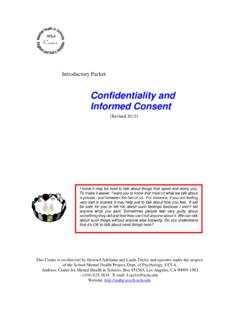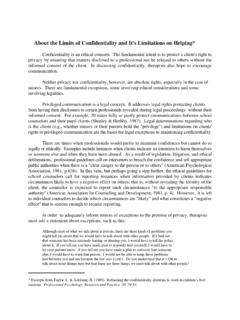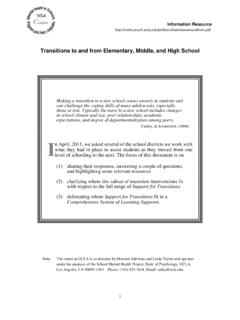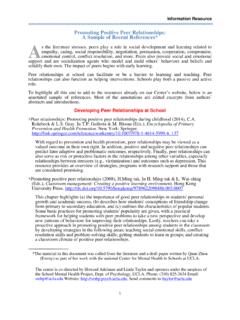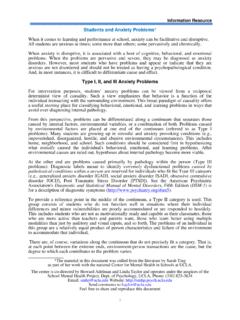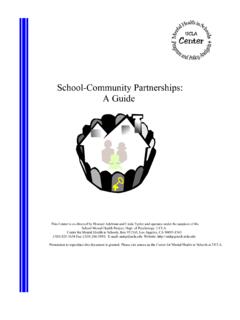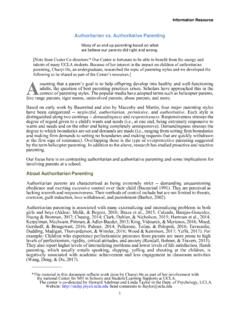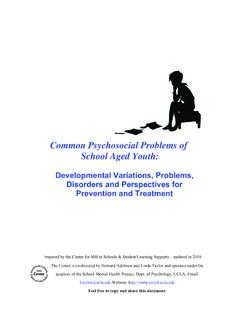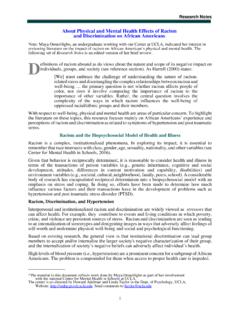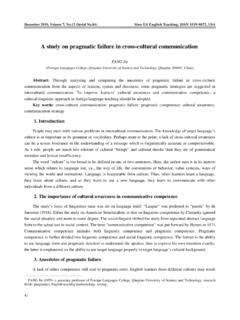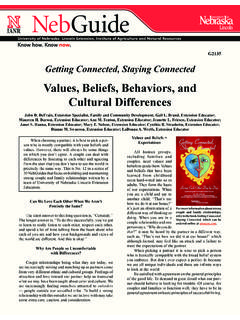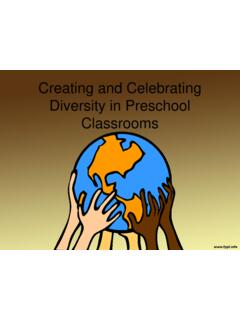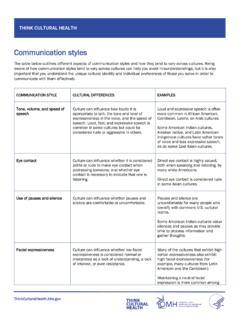Transcription of Cultural Concerns in Addressing Barriers to Learning
1 Introductory packet Cultural Concerns in AddressingBarriers to Learning (revised 2015)*The national Center for Mental Health in Schools is co-directed byHoward Adelman and Linda Taylor and operates under the auspice of the School Mental Health Project, Dept. of Psychology, UCLA. Box 951563, Los Angeles, CA 90095-1563(310) 825-3634 E-mail: Website: Permission to use is grantedWe have all become familiar with certain phrases: Cultural competency,biculturalism, and human [but] What is Culture? .. Culturecan be defined as socially shared beliefs, values, norms, expectations,and practices within a group, community, or society at large. Put simply,culture includes the unspoken rules of conduct within a group, such asacceptable social standards.**Sonika Ung (2015). Integrating culture into psychological research,Association for Psychological Science Observer, 28 Concerns in Addressing Barriers to LearningIntroductionAccounting for Cultural , Racial, and Other Significant Individual and Group DifferencesWhy Consider Culture?
2 An Introductory Outline for Continuing EducationCultural Competency: What it Is and Why it MattersImmigrant Youth: Some Implications for SchoolsImmigrant Children and Youth: Enabling Their Success at SchoolCultural Competence Standards in Managed Care Mental Health Services: Four Underserved/Underrepresented Racial/Ethnic GroupsStaff Development and System ChangeA. The need for a Cultural competence frameworkB. Creating a process for changeC. Broadening the Concept of Cultural CompetenceCultural Competence Issues to ConsiderDeveloping Cultural Competence in Disaster Mental Health Programs: GuidingPrinciples and RecommendationsSelected ReferencesResource Aids: >Profiles of English Learners (Els)> Cultural Competence in Serving Children and Adolescents with Mental Health Problems Fact Sheet>Guidelines for Program Development and Evaluation>APA Guidelines for Providers of Psychological Services to Ethnic, Linguistic, and Culturally Diverse Populations Agencies, Organizations, Advocacy Groups and Internet ResourcesGlossary More Resources>Links to Quick Finds on.
3 Cultural Competence and Related Issues Immigrant Students and Mental Health Diversity, Disparities, and Promoting Health Equitably Native American Students Gay, Lesbian, Bisexual Issues Mental Health in Schools in Other Countries>Links to a few additional recent Center documents: Underrepresented Minorities: Making it to and Staying in Postsecondary Educ. Native American Students Going to and Staying in Postsecondary Education:An Intervention Perspective International Students: Addressing Barriers to Successful Transition Information Resources on Youth Subcultures: Understanding Subgroups to BetterAddress Barriers to Learning & Improve Schools What is the Model Minority Myth and How Should We Deal With It? 2 3 5 6 9121940 4141444850515254555760626668712 IntroductionAt every school in America, staff are dedicated to doing their best to see that allstudents every community, families expect schools to accommodate instruction to thediverse knowledge, skills, and attitudes youngsters bring into the school there is a good match between what families expect and what schools cando, Concerns and conflict do not arise.
4 Unfortunately, many situations existwhere the match needs to be introductory packet is designed to clarify basic Concerns that have relevanceto Addressing Barriers to student Learning and enhancing healthy material provides perspectives and practices related to such matters as:1. Why should school staff be concerned about Cultural and racialdifferences?2. When are such differences a barrier to student Learning and when are theya benefit?3. What are the implications for practice?4. What are the implications for staff development?At the core of all this are issues related to the society s interest in accommodatingand promoting diversity. Thus, policy, politics, social philosophy, and practiceconverge in ways that make any exploration of this topic controversial. In this respect, schools must have a clearer understanding of the many external causes of our socialproblems.
5 Why young people growing up in intergenerational povertyamidst decaying buildings and failing inner-city infrastructures are likelyto respond in rage or despair.. We are beginning to accept that socialproblems are indeed more often the problems of society than theindividual. Family Youth Services Bureau, Department of Health and Human ServicesAs Nicholas Hobbs stated long ago: To take care of them can and should be read with two meanings: togive children help and to exclude them from the community.**Hobbs, N. (1975). The future of children: Categories, labels, and their Franciso: for Cultural , Racial, and Other SignificantIndividual and Group DifferencesThose who work in schools are a diverse group. So are the students and fam ilies who of diversity Concerns identified in research include: age, gender, race, ethnicity,national origin, migration and refugee status and experiences, religion, spirituality, sexualorientation, disability, language, socioeconomic status, education, group identity, communicationmodality, developmental stages, level of acculturation/assimilation, stages of ethnic development,workplace culture, family and lifestyle, and popular , the topic of hum an diversity is fundamental to the processes, content, and outcom es ofschooling.
6 And, of course, diversity competence is central to any discussion of mental health inschools. Our concern in this document is with the competence of school personnel to account forhuman diversity in daily practice in ways that help to address Barriers to lear ning and promotehealthy schools must consider significant individual and group differences . Diversity of stakeholders isa reality at schools. This has benefits and produces problem s. With respect to the latter, direct orindirect accusations that "You don't understand" are common and valid. Indeed, they are all, few of us fully understand complex situations or what others have experienced and , accusing someone of not understanding creates Barriers to working relationships. Afterall, the intent of such accusations is to make others uncomfortable and put them on the of "You don't understand" accusations is one way to reduce Barriers to establishingproductive working generally, discussions of diversity and Cultural com petence provide a foundation foraccounting for such differences .
7 For example, a guide for enhancing Cultural competence (developedby the Family Youth Services Bur eau of the Department of Health and Hum an Services)cautions:Racism, bigotry, sexism, religious discrimination, homophobia, and lack ofsensitivity to the needs of special populations continue to affect the lives of eachnew generation. Powerful leaders and organizations throughout the countrycontinue to promote the exclusion of people who are "different," resulting in thedisabling by-products of hatred, fear, and unrealized potential.. We will notmove toward diversity until we promote inclusion .. Programs will notaccomplish any of (their) central missions unless .. (their approach reflects)knowledge, sensitivity, and a willingness to document outlines baseline assumptions that we broaden to read as follows: Those who work with youngsters and their families can better meet the needs of theirtarget population by enhancing their own competence with respect to group andintragroup differences .
8 Developing such competence is a dynamic, on-going process, not a goal or is, no single activity or event will enhance such competence. In fact, use of a singleactivity reinforces a false sense that the "problem is solved." Diversity training is widely viewed as important, but is not effective in should avoid the "quick fix" theory of providing training without follow-up ormore concrete management and programmatic Hiring staff from the same background as the target population does not necessarilyensure the provision of appropriate services, especially when these personnel are not indecision-making positions, or are not themselves appreciative of, or respectful to, groupand intragroup differences . Establishing a process for enhancing a program's competence with respect to group andintragroup differences is an opportunity for positive organizational and the end, of course, remember that individual differences are the most fundamental determinantof whether a good intervention fit and working relationship are Consider Culture?
9 Culture provides people with a design for living and for interpreting their environment. Culture hasbeen defined as "the shared values, traditions, norms, customs, arts, history, folklore, and institutionsof a group of people." Culture shapes how people see their world and structure their community andfamily life. A person's Cultural affiliation often determines the person's values and attitudes abouthealth issues, responses to messages, and even the use of alcohol and other drugs. A Cultural groupconsciously or unconsciously shares identifiable values, norms, symbols, and ways of living that arerepeated and transmitted from one generation to another. Race and ethnicity are often thought to bedominant elements of culture. But the definition of culture is actually broader than this. People oftenbelong to one or more subgroups that affect the way they think and how they behave.
10 Factors suchas geographic location, lifestyle, and age are also important in shaping what people value and holddear. Organizations that provi de information or services to diverse groups m ust understand theculture of the group that they are serving, and m ust design and m anage culturally competentprograms to address those Competent Programs Cultural competence refers to a set of academic and interpersonal skills that allow individuals toincrease their understanding and appreciation of Cultural differences and similarities within, among,and between groups. This requires a willingness and ability to draw on community- based values,traditions, and customs and to work with knowledgeable persons of and from the community indeveloping targeted interventions, communications, and other supports. A culturally com petentprogram is one that demonstrates sensitivity to and under-standing of Cultural differences in programdesign, implementation, and evaluation.
